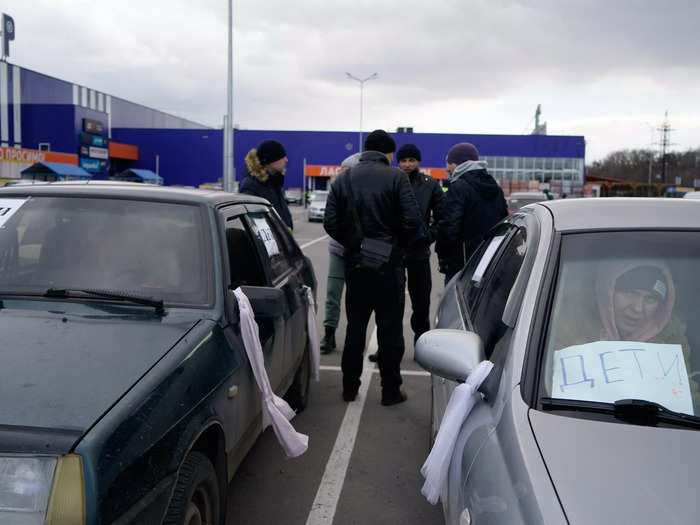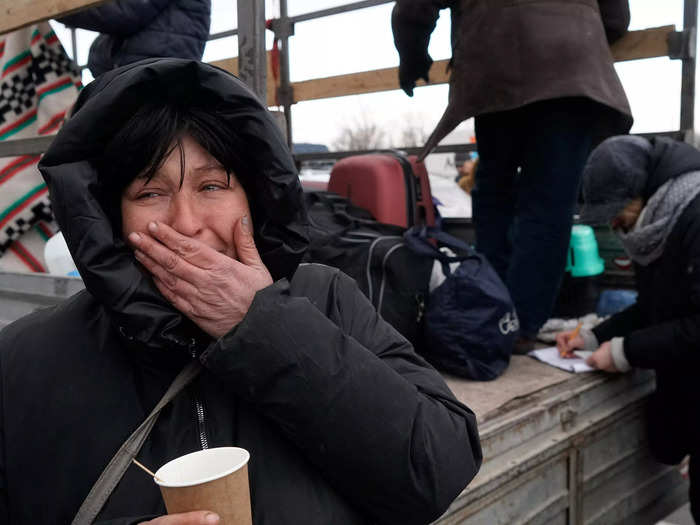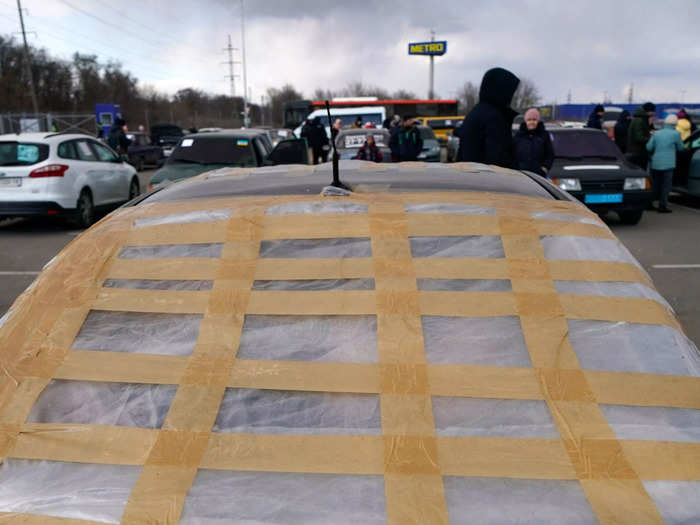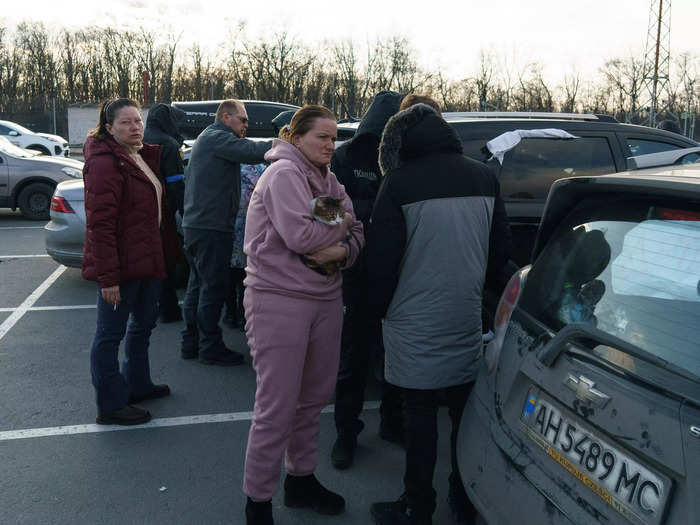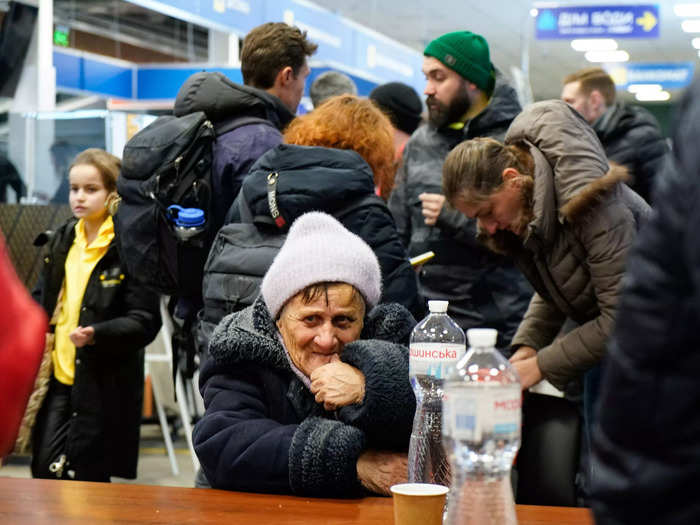People wait at Zaporizhzhya State Circus for transport to other areas of the city on March 16.EMRE CAYLAK/AFP via Getty Images.
- A photojournalist captured images of people fleeing the besieged city of Mariupol.
- Emre Caylak said he saw several cars which had white ribbons and a sign saying "baby" on them.
A photojournalist who has been documenting people fleeing Mariupol said he saw long lines of damaged cars fleeing the city; some carrying white ribbons and paper signs with the word "baby" on them.
Emre Caylak photographed these images of Ukrainians arriving from Mariupol at a shopping mall in Zaporizhzhia, Ukraine, on March 16.
The mall — situated around two hours from Mariupol by car — had been transformed into a registration centre, where people volunteered to process those fleeing the besieged city.
The city is being shelled by Russian fighters, who have targeted and destroyed public buildings, including a theatre, maternity hospital, and art school, according to city officials.
Around 4,000 people — including those photographed by Emre — had fled Mariupol for Zaporizhzhia, Ukrainian President Volodymyr Zelenskyy said on Sunday. Around 100,000 people were still trapped in the city without food, water, power, or medical supplies, he later said in a speech posted to Telegram.
Cars had white ribbons and signs, indicating babies were travelling inside
Emre said cars had white ribbons tied to them, and signs in the window saying "baby." EMRE CAYLAK/AFP via Getty Images.
The photojournalist said there was a line of around 20-30 cars in the entrance to the large shopping mall, all of which were packed with people, their pets, and their belongings.
"Most of the cars arriving had many people in them, 4 sitting cars sometimes had 6 people … every space was filled with stuff. People just tried to fit as much as they could," he told Insider.
Emre said that almost every car he saw had a white ribbon tied to their mirrors and a paper sign stuck to the window bearing the word "baby."
People arrived in cars and trucks loaded with belongings and pets
People were arriving with their belongings loaded onto trucks. Emre said this woman kept "crying on and off." EMRE CAYLAK/AFP via Getty Images.
The photojournalist said that people were often "too emotional" to speak with him. Those he did speak to said they faced long journeys — around two days by car — from Mariupol to Zaporizhzhia, and were often stopped along the way by Russian fighters.
Many had to spend nights sleeping in their car, where they had to keep the heating off to save fuel, he told Insider.
"They didn't have much gas, so they didn't really turn on the heat … it was freezing for them," he said.
The woman pictured above arrived in a group of eight or nine people with a truck full of belongings, Emre said. "She looked at me at first and smiled, then all of a sudden she started crying," he added.
Cars were often shelled leaving Mariupol and had to be taped up, Emre said
Emre said this image was a "very common scene." People taped their cars up, which had been damaged by explosions, he told Insider. EMRE CAYLAK/AFP via Getty Images.
People arrived at the shopping mall car parking lot by car, Emre said. Taped-up cars that had been destroyed by shelling were a "very common scene," he said.
"They all tape them, sometimes they use paper bags to put it in the windows," Emre said.
Several attempts at ceasefires in the port city have failed, making it harder for citizens to escape through safe routes.
Russia's Ministry of Defense called on Ukrainian forces to surrender by early Monday morning and offered to open humanitarian corridors, but Ukrainian officials — who rejected the request — have accused Russia of bombing these passageways.
People who Emre spoke with told him their cars were shelled "for no reason."
People in Mariupol didn't expect the invasion to happen, Emre said
Emre said this scene was also common. "Many people brought their dogs and cats," he told Insider. EMRE CAYLAK/AFP via Getty Images.
Emre — who had been situated in Mariupol a month before the invasion on February 24 — said people had no heating and little food in the weeks after the attack.
"They say it was really cold there; they basically had no heating for a long time. They didn't have much food. A person told me they didn't really eat any meat; they couldn't find anything," Emre told Insider.
People often hugged each other to keep warm, he added.
Emre told Insider he had "good memories" of Mariupol in the month before the invasion, adding that nobody really thought the attack would happen. The photojournalist left the city three days after the invasion on February 27.
The shopping mall was crowded and people would often start crying, Emre said
A woman who fled Mariupol waited in the shopping centre to speak with officers. Emre said often older people "would just start crying." EMRE CAYLAK/AFP via Getty Images.
Inside the shopping mall, Emre said the corridors were "really crowded."
The shops were closed but people were able to have some coffee and food, he said.
The woman pictured above was quite emotional, Emre told Insider.
"One second she would be laughing and they would be chatting and then she would just start crying and get really emotional. She did that like three times in maybe 10 or 15 minutes," Emre added.
"A lot of people like that, especially older people, would just start crying," he said.

